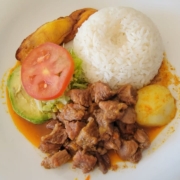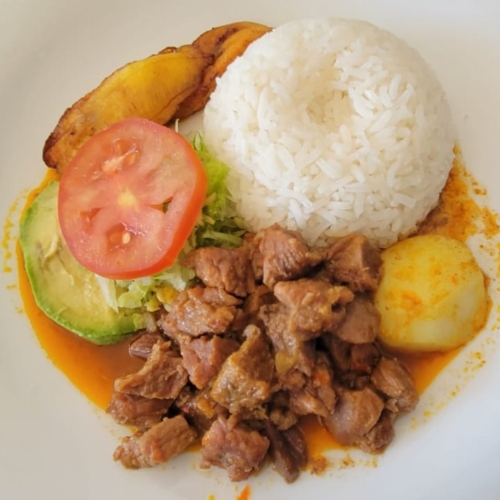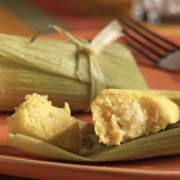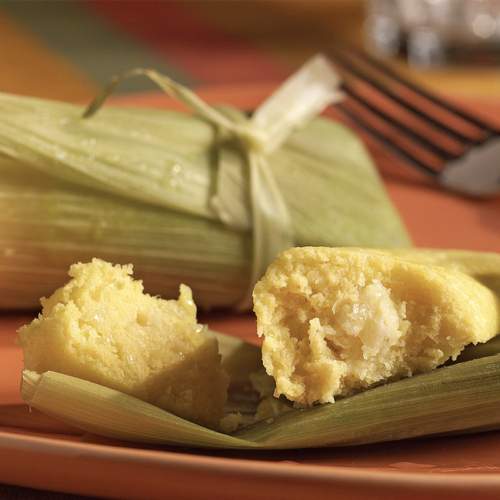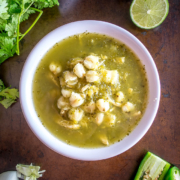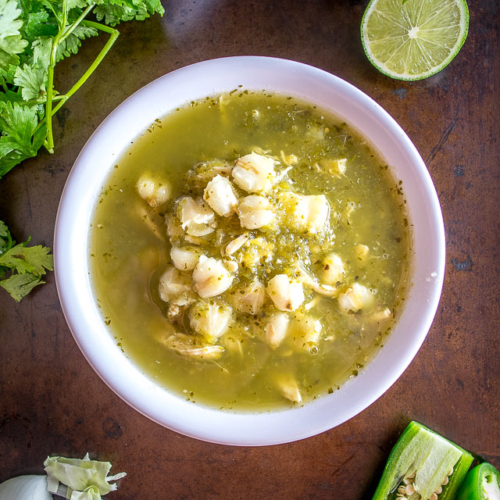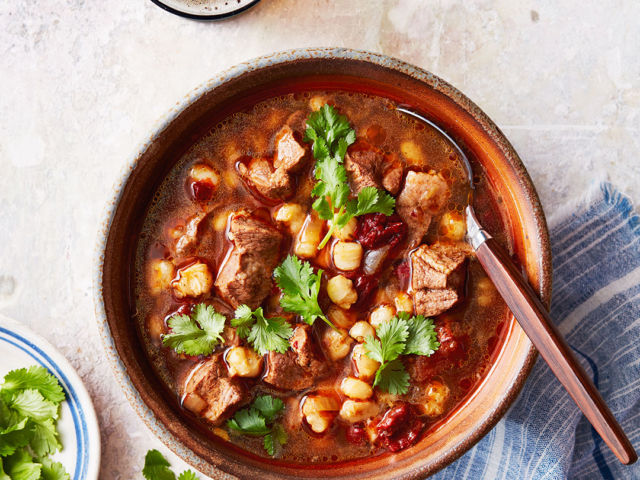Tag Archive for: Latin America
Latin American Seco de Carne
Missionary Nathan Schulte – Latin America mission teamCourse Main Course
Cuisine Ecuadorian, Latin American
Servings 4
Ingredients
- 1 1/2 lbs stew meat cut into 1-inch cubes
- Salt
- Oil
- 1 onion diced
- 3 garlic cloves minced
- 2 tsp ground cumin
- 1 1/2 tsp ground pepper
- 1 tsp ground paprika
- 1 bunch cilantro
- 3 serrano peppers deseeded and chopped
- 1 1/2 cups beef or chicken stock
- 4 potatoes cubed
Instructions
- Preheat oven to 325F. Season meat with lots of salt.
- Add 2 tablespoons of olive oil to large pot over medium heat. Add the meat in one layer once oil is hot. Sear on both sides. Remove from heat and set aside.
- Combine cilantro leaves, your serrano peppers that have been deseeded and chopped, and 1/4 cup of stock. Blend until smooth.
- Cook your onions and then add garlic and cook until fragrant. Stir in cumin, pepper, paprika and pinch of salt.
- Add back in the meat and its juice along with the cilantro mixture and remaining 1 1/4 cup of stock.
- Cover the pot with lid and transfer to the oven. Simmer for 1 ½ - 2 hours or until tender, adding stock as needed. Stir in potatoes and cook for an additional 30 minutes, until potatoes are tender.
- Salt and pepper to taste. Serve over rice and garnish with cilantro.
Notes
We really like seco de carne for lunch!
Keyword Ecuador, Latin America
Ecuadorian Grilled Corn with Cheese Salsa
Missionary Elise Gross – Latin America mission teamCourse Side Dish
Cuisine Ecuadorian
Ingredients
- 1 egg
- 1-2 cloves garlic
- 3/4 cup oil
- 6 oz shredded cheese
- 1 lemon, juiced
- 1/4 cup finely chopped cilantro about 1 medium bunch
- Salt to taste
- 1-2 ears of corn per person
Instructions
- Blend the egg, crushed garlic, cilantro, pinch of salt, and 1/4 cup of oil in a blender.
- Continue to blend and slowly add the rest of the oil until the sauce begins to thicken.
- Add the shredded cheese and lemon juice and blend until you get a creamy sauce.
- Taste and add salt as desired.
- Spoon over roasted corn on the cob and enjoy!
Notes
This is a very popular way to eat corn in Ecuador.
Keyword Ecuador, Latin America
Ecuadorian Llapingachos (Fried potato Pancakes)
Carla Vivar - Missionary WifeCourse Side Dish
Cuisine Ecuadorian
Ingredients
- 2 lbs potatoes peeled
- 1 tbsp salt
- 1 green onion chopped finely
- 2 tbsps parsley minced
- 1 cup queso fresco cheese crumbled
- oil for light frying
- 1/2 head lettuce washed and drained
Instructions
- Quarter potatoes and boil in salted water until the outsides begin to crumble, about 25 minutes.
- Drain and mash until smooth.
- Mix onion and parsley with crumbled cheese.
- Grab a handful of mashed potato and form into a bowl in your palm.
- Place a tablespoon of cheese mixture into a bowl. Seal the potato around the cheese forming a pancake about 1 inch thick and 3 inches wide. Repeat with remaining potatoes.
- Fry each side until brown and crispy in a lightly oiled skillet.
- Shred lettuce. Serve two llapaingachos on shredded lettuce with peanut sauce.
Notes
Typically accompanied by a fried egg and rice.
Ecuadorian Humitas (Ew-me-tas)
Carla Vivar - Missionary WifeCourse Appetizer
Cuisine Ecuadorian
Servings 10 humitas
Ingredients
- 10-30 fresh corn husks if husks are not very wide, put two together
- 4 cups fresh corn kernels if using sweet corn, add milk sparingly
- 2 eggs
- 1-2 cups milk
- 1 tsp salt
- 1/2 tsp sugar
- 2 tbsp butter melted
- 1/2 lb queso fresco cheese well crumbled
Instructions
- Cut each husk from the base of the corn. Carefully peel off. Trim off the top edge. Fold by tucking one side into the other. Tear long pieces of extra husks to tie around "cups". Stick your finger in to open the "cup" for filling. Blend half the corn, 1 egg, and 1/2 cup milk until very smooth. Pour into a bowl. Blend the remaining corn, egg, and another 1/2 cup of milk. Mix with batter in the bowl. Stir in more milk to make a batter that is pourable, similar to pancake batter. Stir in salt and sugar. Mix in butter and cheese. Heat the Humita cooker.**lay the corn cobs in the bottom of a large lidded pot to form a shelf. Just cover the cobs with water and set to boil. Place the filled husks directly on top of the cobs. This works well and smells great.
- Transfer the batter into a pitcher. Pour batter into folded husks. Place each humita upright in a flat-bottomed container ignoring any liquid that seeps out. Repeat using all the batter. Place humitas upright into the cooker.* Cover and steam for 30 to 45 minutes. Periodically Check the water level so you don't burn the pan. The humitas are done when they are solidified. These taste best served hot.*a vegetable steamer also works well as a humita cooker
Notes
Commonly served as an appetizer throughout the country of Ecuador.
Mexican Empanadas
Kay Ulibarri – Christ the Rock, Farmington, N.M.Course Appetizer
Cuisine Mexican, Southwest
Servings 20 empanadas
Ingredients
- 1/2 lb lean ground beef
- 10 oz package frozen patty shells thawed
- 1/4 cup onion minced
- 3 tbsp red chile salsa
- 1 tsp chili powder
- 1/2 tsp ground cumin
- 1/2 tsp garlic powder
- 1/2 tsp ground coriander
- salt and pepper to taste
Instructions
- Crumble beef; saute with onion in a skillet until beef is cooked and onion is soft. Drain.
- Stir in red chile salsa and spices. Set aside.
- Place thawed patty shell dough on a floured board and roll out, in one piece, to about 1/16 inch thickness.
- Cut dough into 3-inch rounds, about 20.
- Put 2 teaspoons of filling on each dough circle; fold in half.
- Moisten edges with water and press edges together with a fork. Place on ungreased cookie sheet. Prick tops with a fork.
- Bake at 400 for 20 minutes or until golden brown. Serve hot.
Venezuelan Tequeños
Rachel Hartman – Missionary WifeCourse Appetizer
Cuisine Latin American, Venezuelan
Servings 4
Ingredients
- 2 cups flour
- 1 tsp kosher salt
- 1/4 tsp baking powder
- 6 tbsp unsalted butter
- 1 large egg
- 6 tbsp cold water plus more if needed
- 12 oz queso blanco or "cheese for frying"
- vegetable oil for frying
Instructions
- Cut butter in 1/4 inch slices.
- Place butter slices, 2 cups flour, and baking powder in a food processor.
- Pulse until butter is mixed in and the flour is crumbly.
- Place mixture in a large bowl.
- Add egg and water. Mix with a spatula to form a ball. Add water, tablespoon by tablespoon, if needed.
- Wrap ball in plastic wrap and place in fridge for 30 minutes.
- Take out and roll out the dough to 1/8 inch thickness, forming a 12 x 12 inch square. Slice into 3/4 inch strips.
- Slice cheese into strips that measure 1/2 inch x 1/2 inch x 2 1/2 inches.
- Take a strip and wrap it in a spiral around the cheese, covering all the cheese. Pinch dough to seal in cheese.
- Heat oil in a large, deep cast iron pan or fryer. When hot (400 degrees), add the dough-wrapped cheese sticks in small batches and fry for three to five minutes, or until golden. Flip halfway through if needed.
- Place on paper towel and continue with next batches.
- Serve and enjoy!
Video
Notes
Tequeños are from Venezuela and are a popular dish in our city of Doral, Florida, which has many Venezuelan immigrants. Our kids love them, and they are served at parties, get togethers, church potlucks, and as appetizers.
Keyword Latin America
Anasazi Beans & Ham
Marianne Jensen – Christ the Rock, Farmington, N.M.Course Main Course, side
Cuisine Southwest
Servings 8
Ingredients
- 2 cups dry Anasazi Beans rinsed and sorted
- 1 large onion
- 2 cloves garlic crushed
- 3/4 - 1 lb bone in ham steak cubed
- 4 ounces can diced green chiles
- salt and pepper to taste
Instructions
- Rinse dried beans and sort for stems and stones. In a large stock pot, cover beans with 3 quarts water and bring to a boil. Cook covered at a gentle boil for 1 to 1 1/2 hours or until beans begin to soften (this will happen more quickly at lower altitudes).
- Add remaining ingredients and continue cooking for 3-4 hours or until all liquid is absorbed. Heat may be reduced from boiling once onions have softened and become transparent.
- To avoid scorching at higher altitudes, beans may be finished in a 350 degree oven, but should be stirred every 20-30 minutes. Remove ham bone before serving.
- Serve warm with tortillas or cornbread.
Notes
Anasazi beans are a special cultivar of pinto bean cultivated from 600 year-old seed beans found in Ancestral Pueblo ruins of the Four Corners in the early 1900's. They have a thinner skin, cook more quickly, produce less gas, and can be ordered online from Adobe Milling of Dove Creek, CO.
Posole Verde
Kay Ulibarri – Christ the Rock, Farmington, N.M.Course Main Course
Cuisine Mexican, Southwest
Servings 10
Ingredients
- 1 pound frozen posole or canned hominy drained
- 3/4 lb fresh pblano chiles (about 4) seeded, deveined, and chopped
- 1 cup chopped white onion
- 3 garlic cloves
- 16 fresh parsley sprigs with stems
- 2 cups vegetable broths divided
- 1 lime juiced (additional lime wedges for garnish)
- 6 radishes sliced
- fresh cilantro
- sour cream optional
Instructions
- Cook posole, covered in 1 quart unsalted water over medium low heat, stirring occasionally until soft but not mushy, about 3 hours for dried or 1 1/4 hour for frozen. Add more water as needed.
- Meanwhile, trim one inch off the bottom stems of parsley and cilantro and discard. Roughly chop remaining leaves and stems. Puree the poblanos, onion, garlic, parsley, cilantro, and 1/2 cup broth in a blender until smooth.
- When posole is just starting to split open, pour chile mixture over it and stir to combine. Add enough of the remaining stock to make posole soupy. Continue to simmer, uncovered, until posole is tender, adding more stock if necessary, about 45 minutes. Stir in lime juice. Serve with lime wedges, radishes, cilantro, and sour cream if desired.
Posole Stew
Kay Ulibarri – Christ the Rock, Farmington, N.M.Course Soup
Cuisine Mexican, Southwest
Servings 16
Ingredients
- 1 lb lean pork shoulder
- 2 lb frozen posole hominy
- 1 lime juiced
- 2 tbsp course red chile powder
- 3 garlic cloves
- 1/4 tsp dried oregano
- 3 tbsp salt
Instructions
- Cook the pork in a pressure cooker, with water to cover, for 20 minutes.
- Reduce pressure under cold water. Open pot and add posole, lime juice, and chile.
- Add water - about twice as much as the amount of posole.
- Cook for 45 minutes under pressure.
- Reduce pressure under cold water. 2. Remove the pork and cut up.
- Put posole, pork, garlic, oregano, and salt in a large covered pot and simmer 1-3 hours, or until hominy kernels have burst and are soft but not mushy. Serve alone or as a side dish.
Notes
The cooking times are for higher altitude cooking. At lower altitudes, where the boiling point is higher, you may need to try shorter cooking times.
Taste of Missions
This annual hybrid event, hosted by WELS Missions, will provide all WELS members an opportunity to connect with brothers and sisters in Christ from around the globe and be a part of the important gospel outreach occurring through our synod.
CONNECT
Fill out the WELS Contact Us form to submit any questions you have about Taste of Missions.
Find us on social
Facebook
Instagram

